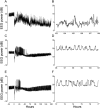Connexin hemichannel blockade improves survival of striatal GABA-ergic neurons after global cerebral ischaemia in term-equivalent fetal sheep
- PMID: 28740229
- PMCID: PMC5524909
- DOI: 10.1038/s41598-017-06683-1
Connexin hemichannel blockade improves survival of striatal GABA-ergic neurons after global cerebral ischaemia in term-equivalent fetal sheep
Abstract
Basal ganglia injury at term remains a major cause of disability, such as cerebral palsy. In this study we tested the hypotheses that blockade of astrocytic connexin hemichannels with a mimetic peptide would improve survival of striatal phenotypic neurons after global cerebral ischaemia in term-equivalent fetal sheep, and that neuronal survival would be associated with electrophysiological recovery. Fetal sheep (0.85 gestation) were randomly assigned to receive a short or long (1 or 25 h) intracerebroventricular infusion of a mimetic peptide or vehicle, starting 90 minutes after 30 minutes of cerebral ischaemia. Sheep were killed 7 days after ischaemia. Cerebral ischaemia was associated with reduced numbers of calbindin-28k, calretinin, parvalbumin and GAD positive striatal neurons (P < 0.05 ischaemia + vehicle, n = 6 vs. sham ischaemia, n = 6) but not ChAT or nNOS positive neurons. Short infusion of peptide (n = 6) did not significantly improve survival of any striatal phenotype. Long infusion of peptide (n = 6) was associated with increased survival of calbindin-28k, calretinin, parvalbumin and GAD positive neurons (P < 0.05 vs. ischaemia + vehicle). Neurophysiological recovery was associated with improved survival of calbindin-28k, calretinin and parvalbumin positive striatal neurons (P < 0.05 for all). In conclusion, connexin hemichannel blockade after cerebral ischaemia in term-equivalent fetal sheep improves survival of striatal GABA-ergic neurons.
Conflict of interest statement
The authors declare that they have no competing interests.
Figures






Similar articles
-
Connexin Hemichannel Mimetic Peptide Attenuates Cortical Interneuron Loss and Perineuronal Net Disruption Following Cerebral Ischemia in Near-Term Fetal Sheep.Int J Mol Sci. 2020 Sep 4;21(18):6475. doi: 10.3390/ijms21186475. Int J Mol Sci. 2020. PMID: 32899855 Free PMC article.
-
Connexin hemichannel blockade improves outcomes in a model of fetal ischemia.Ann Neurol. 2012 Jan;71(1):121-32. doi: 10.1002/ana.22654. Ann Neurol. 2012. PMID: 22275258
-
nNOS inhibition during profound asphyxia reduces seizure burden and improves survival of striatal phenotypic neurons in preterm fetal sheep.Neuropharmacology. 2014 Aug;83:62-70. doi: 10.1016/j.neuropharm.2014.03.017. Epub 2014 Apr 12. Neuropharmacology. 2014. PMID: 24726307 Free PMC article.
-
Deleterious effects of high dose connexin 43 mimetic peptide infusion after cerebral ischaemia in near-term fetal sheep.Int J Mol Sci. 2012;13(5):6303-6319. doi: 10.3390/ijms13056303. Epub 2012 May 22. Int J Mol Sci. 2012. PMID: 22754366 Free PMC article.
-
Non-additive effects of delayed connexin hemichannel blockade and hypothermia after cerebral ischemia in near-term fetal sheep.J Cereb Blood Flow Metab. 2015 Dec;35(12):2052-61. doi: 10.1038/jcbfm.2015.171. Epub 2015 Jul 15. J Cereb Blood Flow Metab. 2015. PMID: 26174327 Free PMC article.
Cited by
-
Therapeutic Hypothermia Attenuates Cortical Interneuron Loss after Cerebral Ischemia in Near-Term Fetal Sheep.Int J Mol Sci. 2023 Feb 12;24(4):3706. doi: 10.3390/ijms24043706. Int J Mol Sci. 2023. PMID: 36835117 Free PMC article.
-
Therapeutic strategies targeting connexins.Nat Rev Drug Discov. 2018 Dec;17(12):905-921. doi: 10.1038/nrd.2018.138. Epub 2018 Oct 12. Nat Rev Drug Discov. 2018. PMID: 30310236 Free PMC article. Review.
-
Glia and hemichannels: key mediators of perinatal encephalopathy.Neural Regen Res. 2018 Feb;13(2):181-189. doi: 10.4103/1673-5374.226378. Neural Regen Res. 2018. PMID: 29557357 Free PMC article. Review.
-
Astrocyte Networks as Therapeutic Targets in Glaucomatous Neurodegeneration.Cells. 2021 Jun 2;10(6):1368. doi: 10.3390/cells10061368. Cells. 2021. PMID: 34199470 Free PMC article. Review.
-
Anatomy of hypothalamic and diencephalic nuclei involved in seasonal fertility regulation in ewes.Front Vet Sci. 2023 Feb 16;10:1101024. doi: 10.3389/fvets.2023.1101024. eCollection 2023. Front Vet Sci. 2023. PMID: 36876003 Free PMC article.
References
Publication types
MeSH terms
Substances
LinkOut - more resources
Full Text Sources
Other Literature Sources

